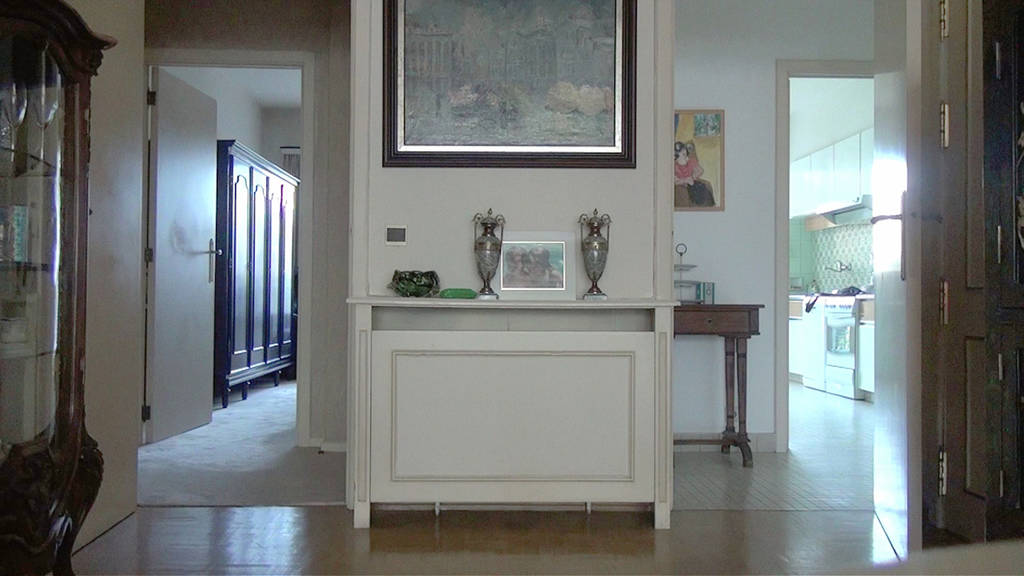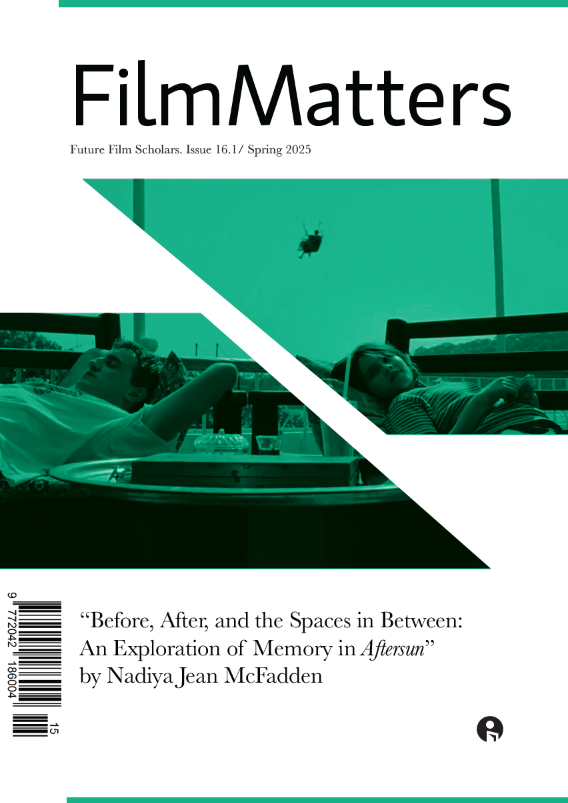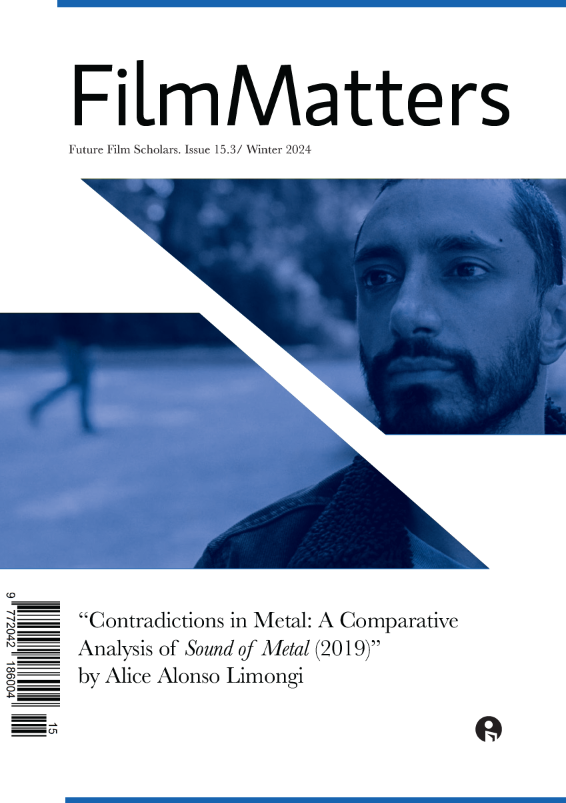E is for encounter, and exchange, which are one and the same. E is also for “eyes,” those objects through which our encounters and exchanges take place: eyes through screens, eyes glancing toward cameras, eyes deliberately not glancing toward cameras, eyes closing. The acknowledgement of a screen, the slow eyelid droop of an afternoon nap. Encounter is, first and foremost, about what we see.
Certainly, as a spectator of something like Chantal Akerman’s No Home Movie, the filmmaker’s last documentary (centered around her relationship with her elderly mother), we have no choice but to use our eyes: not passively, as so many films allow us to do, where image after image is shot at us, easily digestible, satisfying, like a bag of chips. Instead, No Home Movie forces us to prolong our encounter with each shot, and each subject in the shot. It challenges us even further by giving us many, many shots where there doesn’t appear to be a subject at all, at least not the digestible kind, which, for us, is the human subject.
Akerman makes us sit until we start to itch. But if we can overcome the itching, we start to use our eyes in ways we’re not accustomed to. We use them to see the details of a room, the pictures in the frames, the pattern on the carpet. We use them to see the subtleties of the body, the shuffling of feet. We begin to recognize movements, so forced into attentiveness that they become familiar. We are constantly reminded of the position of the camera, although Akerman herself remains obscured. What results is a sort of mirroring of herself in her mother, her voice often behind the frame, and us entering a sort of “play of mirrors,”[i] with the lens of the camera positioned like a household object, creeping into the intimate corners of Akerman’s life yet always prominent, bringing awareness to itself. Everything becomes imbued with reflection.
The push, this prolonged encounter, is an invitation to exchange. Exchange is a porous interaction, the kind that is only possible if borders are softened, if things are made vulnerable. When I say things, I do literally mean things: the thingness of people, tables. But also, the thingness of light, the thingness of air. I’m thinking of the body as thing,[ii] both our bodies and the bodies on screen. Sound is involved in this encounter. Akerman allows the mic to pick up every sound, offensive and inoffensive: every wind, every creak and shuffle, every throat-clearing, birds outside the window, the cars passing, deep coughs. We become aware of air, of the way it fills spaces and carries sound. Air and light thicken like water. Sound becomes substantial, as raw as the images, opening itself to the viewer like an invitation.
Of course, we don’t encounter sound, or any of the elements of the film, as though we were actually in the room: and Akerman doesn’t need us to. We’re always aware of the camera, as yet another “thing” in this coagulation of things, as the thing that mediates our encounter, but does not detract from it. Space on screen opens up to us, invites us to step into the house when nobody is home, invites us to sit around the corner and eavesdrop on the table talk. As spectators, we too become things, like the air and light, that silently witness.
F, then, is for the “silent witnesses” so prevalent in this film: furniture. Which also has to do with framing and focus. By framing a space full of objects, we linger on them longer than we would in a film where space is simply the backdrop. Turning our focus to furniture causes us to become aware of their capacities, what Lesley Stern refers to as actants.[iii] In still shots of domestic interiors, we become aware of the lives of these different chairs, tables, knick-knacks, lamps, and the affective capacities they can exert on the characters and other objects in the film as well as on us.
There’s a sense that these things have been collected over time, carried in from somewhere else. Now they sit and gather dust and are dusted, bathe in the flickering light through the window. The recliner and couch that beckon an afternoon nap, the fragile china and glass in a polished wood cabinet. Photographs in frames. Vases. When we focus on these items, conquer that sluggish boredom that overcomes us in a fast-moving world when we are suddenly brought to a stop, we’re forced to notice them in a way that imbues them with new life. Furniture, we realize, bears traces of memory, marks the passage of time. I can’t help but wonder: were any of these Akerman’s grandmother’s? Are these wedding gifts, or antiques from stores?
There is, ever-present and ghostly, the fact that this stillness is the calm that has followed a brutal storm. We know that Akerman’s mother is an Auschwitz survivor. We know that all of these objects, collected in this place, are comforts that can never fully obscure an underlying scar. We never see what Akerman’s mother went through. We can only imagine it. But the horror of the Holocaust is unimaginable, especially, it seems, for those who lived through it: and so, these objects, indifferent, silent, stand sentinel and are the observers and containers of that which we cannot observe or contain. The curtain in the wind shifts the light, casts shadows over the polished porcelain in the hallway. The film itself is an object imprinted with memory, something that remains stable even as the world around it changes and changes how we see it. Ackerman and her mother have passed, but their impressions linger on the screen, flickering.
G, then, is for ghostly. But it is also for green: the green cut of a freshly mowed lawn, the delightful green of a houseplant, the rolling, tame green of the dog park. After nearly five minutes of a dusty and abrasive landscape throwing rough wind against the mic, green is a sigh. Not the green of a traffic light, but rather the opposite, a green that tells you to stop, be still, be slow. There’s the somewhat clammy, eerie green of the kitchen, at times: a ghostly green, like the glow of an empty swimming pool at night. Green, in a sense, is life and death: the shades range from the breath of something growing to the whisper of something dead.
Maggie Nelson says in Bluets that “it is the business of the eye to make colored forms out of what is essentially shimmering.”[iv] No object is imbued with color, yet it remains to us moving, disturbing, overwhelming, calming. Color can pierce our shell. And yet, we can never grasp color: it is both within us, a delicate play of microscopic conic structures sending rapid pulses to our brains, and without us, it remains shifting, fading, reacting to light and temperature and the chemical processes of the world. Color, as Nelson seems to suggest, is something intimate, and also something perpetually out of reach. A sort of yearning.
Maybe, then, to be intimate means to invite in the ghosts. Maybe intimacy doesn’t mean that we have to make our ghosts corporeal, force them to talk, or get anything profound out of them. Maybe intimacy is just letting ghosts sit at the table, like the wind leaks through trees, like the light leaks through windows, like color seeps into our eyes. So we end where we began: with eyes, through which our encounters are mediated, through which the light of the cinema screen dances like a familiar ghost.
Author Biography
Annie Martin graduated with an English BA from Amherst College last December. She currently lives and works in New York City.
[i] Trinh, Minh-ha. Woman, Native, Other: Writing Postcoloniality and Feminism. Indiana University Press, 1989.
[ii] As Lesley Stern does in Dead and Alive: The Body as Cinematic Thing. Caboose, 2012
[iii] According to Stern, objects become “actants” when they cause us to act upon them.
[iv] Nelson, Maggie. Bluets. Wave Books, 2009.








































